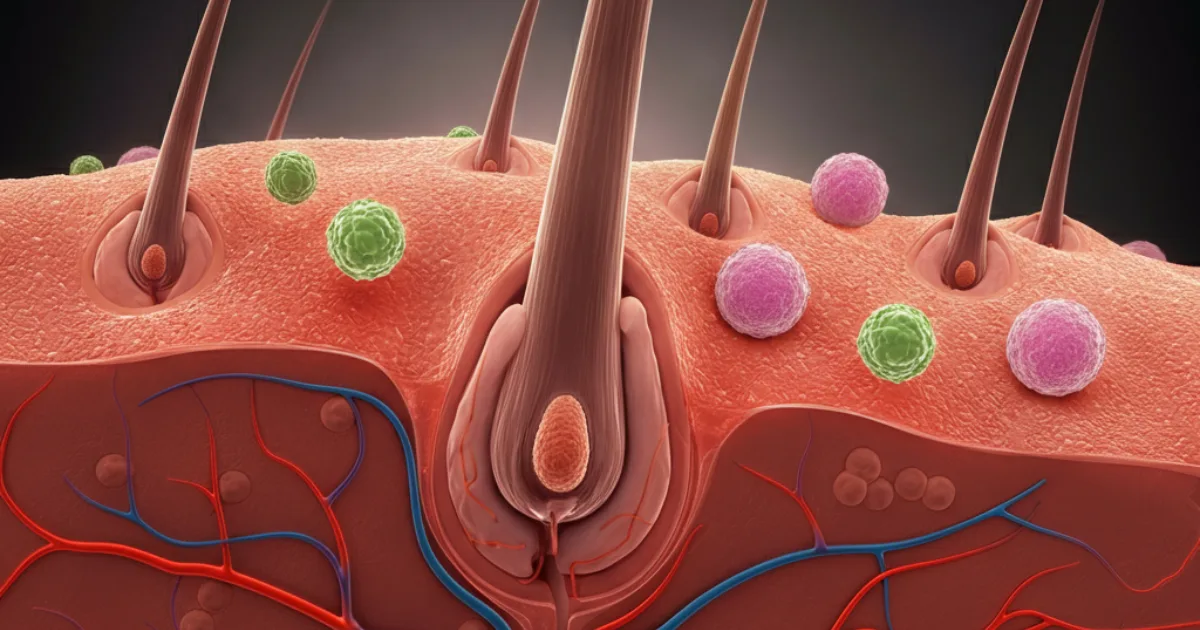Have you ever wondered how much your hair grows in a year? Maybe you’re trying to grow out a bad haircut, or perhaps you’re curious about why your hair seems to grow faster or slower than others. Hair growth is something we all experience, but it’s also a topic full of myths, questions, and fascinating science. In this article, we’ll break down everything you need to know about hair growth in a way that’s easy to understand, no matter your age. From how much hair typically grows in a year to the science behind it, we’ve got you covered with clear, friendly, and SEO-friendly information.
How Much Does Hair Grow in a Year?
On average, human hair grows about 6 inches (15 centimeters) per year. That’s roughly 0.5 inches (1.25 centimeters) per month or about 0.013 inches (0.33 millimeters) per day. These numbers are just an average, though, and hair growth can vary from person to person based on factors like genetics, age, health, and lifestyle.
Imagine this: if you never cut your hair for a year, you could expect it to be about 6 inches longer by the end of the year. For some people, it might grow a little faster—up to 8 inches a year—while for others, it might be a bit slower. Curious about why this happens? Let’s dive into the science of hair growth to understand what’s going on beneath the scalp.
The Science Behind Hair Growth

Hair growth might seem like a simple process, but it’s actually a complex cycle driven by biology. Your hair grows from tiny structures in your skin called hair follicles. Each follicle is like a little factory that produces hair, and it goes through a specific cycle to keep your hair growing, resting, and renewing. This cycle has three main phases:
1. Anagen Phase (Growth Phase)
This is when your hair is actively growing. The anagen phase lasts anywhere from 2 to 7 years, depending on your genetics. During this time, cells in the hair follicle divide rapidly, pushing the hair strand longer. About 85-90% of the hairs on your head are in the anagen phase at any given time. The length of this phase determines how long your hair can grow before it naturally stops.
- Fun Fact: People with naturally long hair often have a longer anagen phase, while those with shorter hair might have a shorter one.
2. Catagen Phase (Transition Phase)
After the growth phase, the hair follicle enters the catagen phase, which lasts about 2-3 weeks. During this time, the follicle shrinks, and hair growth slows down. The hair detaches from its blood supply, preparing to rest. Only about 1-2% of your hair is in this phase at any moment.
3. Telogen Phase (Resting Phase)
This is the resting phase, where the hair just chills out for about 2-3 months. The hair stays in the follicle but doesn’t grow. Eventually, the old hair falls out, and a new hair starts growing in its place, kicking off a new anagen phase. About 10-15% of your hair is in the telogen phase at any time.
When you see hair on your brush or in the shower, it’s usually from the telogen phase, as the old hair is pushed out by new growth. Don’t worry—losing 50-100 hairs a day is totally normal!
Factors That Affect Hair Growth
Why does hair grow faster for some people and slower for others? Here are the main factors that influence how much your hair grows in a year:
1. Genetics
Your DNA plays a huge role in hair growth. It determines the length of your anagen phase, the thickness of your hair, and even how many hair follicles you have (on average, humans have 100,000 to 150,000 follicles on their scalp). If your parents have fast-growing or thick hair, you’re more likely to have it too.
2. Age
As we age, hair growth can slow down. The anagen phase tends to get shorter, and hair follicles might produce thinner or weaker hair. This is why some older adults notice their hair doesn’t grow as long or as quickly as it did when they were younger.
3. Nutrition
Your hair needs nutrients to grow strong and healthy. Key players include:
- Protein: Hair is made of a protein called keratin, so eating enough protein (like eggs, fish, or beans) is essential.
- Vitamins: Biotin (vitamin B7), vitamin D, and vitamin E support hair health.
- Minerals: Iron, zinc, and magnesium are crucial for hair growth.
A poor diet can lead to slower hair growth or even hair loss, so eating a balanced diet is key.
4. Hormones
Hormones can speed up or slow down hair growth. For example:
- Pregnancy: Many women notice faster hair growth during pregnancy due to increased estrogen levels.
- Stress: High stress can push more hairs into the telogen phase, leading to temporary hair shedding.
- Medical Conditions: Conditions like thyroid disorders or polycystic ovary syndrome (PCOS) can affect hair growth.
5. Hair Care Habits
How you treat your hair matters. Overusing heat tools, harsh chemicals, or tight hairstyles can damage hair and make it seem like it’s not growing (even though it’s breaking off). Gentle care, like using sulfate-free shampoos and avoiding excessive heat, can help your hair reach its full growth potential.
6. Health and Lifestyle
Smoking, lack of sleep, and chronic stress can all impact hair growth. Staying active, getting enough rest, and managing stress can keep your hair growing at its best.
Can You Make Your Hair Grow Faster?

Everyone wants long, luscious hair, but is there a way to speed up the process? While you can’t drastically change your hair’s growth rate (thanks, genetics!), you can create the best conditions for healthy growth. Here are some tips:
1. Eat a Hair-Healthy Diet
Load up on foods rich in protein, biotin, and other hair-loving nutrients. Think eggs, salmon, avocados, nuts, and leafy greens. Drinking enough water also keeps your scalp hydrated and healthy.
2. Take Care of Your Scalp
A healthy scalp is the foundation for healthy hair. Try:
- Scalp Massages: Massaging your scalp for 5-10 minutes a day can increase blood flow to the follicles, potentially boosting growth.
- Gentle Cleansing: Use a mild shampoo to keep your scalp clean without stripping natural oils.
3. Avoid Damage
Protect your hair from breakage by:
- Limiting heat styling (blow dryers, flat irons, etc.).
- Using a wide-tooth comb to detangle wet hair.
- Avoiding tight ponytails or braids that pull on your hair.
4. Consider Supplements
If your diet is lacking, a supplement like biotin or a multivitamin might help. Always talk to a doctor before starting supplements to make sure they’re right for you.
5. Be Patient
Hair growth takes time. Even with the best care, your hair will still grow at its natural pace—around 6 inches a year for most people. Consistency is key!
Common Hair Growth Myths Debunked
There are tons of myths about hair growth floating around. Let’s clear up a few:
- Myth 1: Cutting your hair makes it grow faster.Truth: Trimming your hair doesn’t affect the growth rate at the follicle. However, regular trims (every 8-12 weeks) can remove split ends, making your hair look healthier and longer.
- Myth 2: Brushing your hair 100 times a day makes it grow.Truth: Overbrushing can actually damage your hair and cause breakage. Brush gently to detangle, and that’s enough.
- Myth 3: Certain products can double your hair growth.Truth: No shampoo or oil can drastically speed up hair growth. Products can improve hair health and reduce breakage, but they don’t change your hair’s natural growth cycle.
Why Does Hair Growth Vary by Hair Type?
Not all hair grows at the same rate or in the same way. Here’s how hair type plays a role:
- Straight Hair: Often appears to grow faster because it lies flat, making length more noticeable.
- Curly or Coily Hair: May seem to grow slower because curls coil tightly, but the actual growth rate is similar. Shrinkage can make curly hair look shorter than it is.
- Fine vs. Thick Hair: Fine hair might break more easily, making growth less noticeable, while thick hair tends to be stronger.
No matter your hair type, the average growth rate of 6 inches per year still applies—it’s just how the hair looks that differs.
When Should You Worry About Hair Growth?
If you notice your hair isn’t growing as expected or you’re losing more than 100 hairs a day, it might be worth checking in with a doctor or dermatologist. Possible causes of slow growth or hair loss include:
- Nutritional deficiencies (like low iron or vitamin D).
- Hormonal imbalances (thyroid issues, PCOS, etc.).
- Stress or medical conditions.
- Scalp issues like dandruff or infections.
A professional can help figure out what’s going on and suggest treatments, like dietary changes or medications.
Fun Facts About Hair Growth
- Hair is one of the fastest-growing tissues in the human body, second only to bone marrow.
- Your hair grows faster in warmer months because increased blood flow to the scalp can stimulate follicles.
- Scalp hair grows faster than body hair, which has a shorter anagen phase.
Conclusion
So, how much does hair grow in a year? For most people, it’s about 6 inches, but this can vary based on genetics, health, and how well you care for your hair. Understanding the science behind hair growth—like the anagen, catagen, and telogen phases—helps explain why hair grows the way it does. By eating a balanced diet, taking care of your scalp, and avoiding damage, you can support your hair’s natural growth cycle and keep it looking its best.
Whether you’re growing out a pixie cut or just curious about your locks, remember that patience and consistency are your best friends. Hair growth is a slow but steady process, and with the right care, you’ll be amazed at how healthy and long your hair can get in a year!

